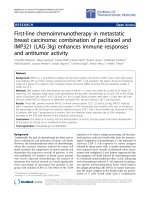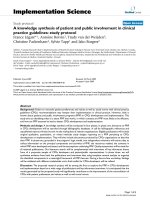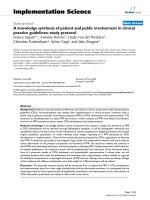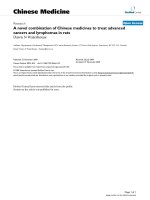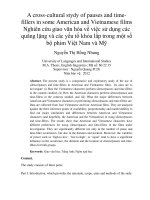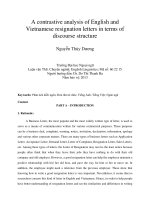A Novel Combination of Negative and Positive Selection in Artificial Immune Systems
Bạn đang xem bản rút gọn của tài liệu. Xem và tải ngay bản đầy đủ của tài liệu tại đây (162.99 KB, 10 trang )
VNU Journal of Science: Comp. Science & Com. Eng. Vol. 31, No. 1 (2015) 22–31
A Novel Combination of Negative and Positive Selection in
Artificial Immune Systems
Van Truong Nguyen
1
, Xuan Hoai Nguyen
2
, Chi Mai Luong
3
1
Thai Nguyen University of Education, Thai Nguyen, Vietnam
2
Hanoi University, Hanoi, Vietnam
3
Vietnamese Academy of Science and Technology, Hanoi, Vietnam
Abstract
Artificial Immune System (AIS) is a multidisciplinary research area that combines the principles of immunology
and computation. Negative Selection Algorithms (NSA) is one of the most popular models of AIS mainly designed
for one-class learning problems such as anomaly detection. Positive Selection Algorithms (PSA) is the twin brother
of NSA with quite similar performance for AIS. Both NSAs and PSAs comprise of two phases: generating a set D
of detectors from a given set S of selves (detector generation phase); and then detecting if a given cell (new data
instance) is self or non-self using the generated detector set (detection phase). In this paper, we propose a novel
approach to combining NSAs and PSAs that employ binary representation and r-chunk matching rule. The new
algorithm achieves smaller detector storage complexity and potentially better detection time in comparison with
single NSAs or PSAs.
c
2015 Published by VNU Journal of Science.
Manuscript communication: received 17 February 2014, revised 01 March 2015, accepted 25 March 2015
Corresponding author: Van Truong Nguyen,
Keywords: Artificial immune systems, Negative selection, Positive selection, Intrusion detection, Detector
1. Introduction
The biological immune system is a mature
defense system which has evolved over millions
of years. As a defense system, it is
incredibly robust, adaptive, and inherently
distributed. The immune system posses powerful
pattern recognition, learning, and memory
capabilities. It has evolved complex methods
for combating infections caused by viruses
and other pathogens, without apparently any
central coordination or control. Its ability
to distinguish between pathogens and non-
pathogens has inspired a number of artificial
immune systems on computers [1]. The
representative immune cell is the T cell,
which has a self-recognition component and an
antigen receptor for locating and eliminating
infected pathogens. The learning process of
the biological immune system does not require
negative examples and acquired knowledge is
represented in an explicit form: T cells are
generated randomly and in a large number, in the
hope that every pathogen that might infect the
host could be detected by at least some of these
cells. However, the host must ensure that no cell
generated would turn against itself (autoimmune
reactions). Hence, newborn T cells undergo the
process of selection to ensure that they are able to
recognize non-self peptides. This process might
be conducted in two ways: positive selection and
negative selection. In negative selection, if a
T cell detects any self protein, it is discarded;
otherwise, it is kept. By contrast, in positive
selection, if a T cell fails to recognize any of the
self proteins, it is removed [2].
V.T. Nguyen et al. / VNU Journal of Science: Comp. Science & Com. Eng. Vol. 31, No. 1 (2015) 22–31 23
Negative selection algorithms (NSA)
and positive selection algorithm (PSA) are
computational models that have been inspired by
negative and positive selection of the biological
immune system. Among the two, NSA has
been studied more extensively resulting in more
variants and applications [3]. However, all of
existing NSAs have worst-case exponential
memory complexity for storing the detector set,
hence, limit their practical applicabilities [4]. In
this paper, we propose a novel selection algorithm
that employs binary representation and r-chunk
matching rule for detectors. The new algorithm
combines negative and positive selection to
reduce both detector storage complexity and
detection time, while maintaining the same
detection coverage as that of NSAs (PSAs).
The rest of the paper is organized as follows.
In the next section, we present the background
on PSAs, NSAs and r-chunk matching rule for
detectors. Section 3 briefly describes the work
in the literature that are most related to our new
approach. Section 4 details our new selection
algorithm with theoretically proven results on
detector storage optimization and preliminary
experimental results on detection time. Section
5 concludes the paper and discuss some possible
future work.
The main contributions of this paper, compared
to our previous work [5], are three-folds: a more
general proof of detector storage complexity, an
extension of related works, and an experiment of
our algorithm on real network intrusion dataset.
2. Background
In this section we first briefly describe NSAs
and PSAs. Then, the r-chunk matching rule is
defined and discussed.
2.1. Negative Selection Algorithms
NSAs are among the most popular and
extensively studied techniques in artificial
immune systems that simulate the negative
selection process of the biological immune
system. A typical NSA comprises of two phases:
detector generation and detection [6, 7]. In
the detector generation phase (Figure. 1.a),
the detector candidates are generated by some
random processes and censored by matching
them against given self samples taken from a
set S (representing the system components).
The candidates that match any element of S
are eliminated and the rest are kept and stored
in the detector set D. In the detection phase
(Figure. 1.b), the collection of detectors are used
to distinguish self (system components) from
non-self (outlier, anomaly, etc). If incoming data
instance matches any detector, it is claimed as
non-self or anomaly.
End
Input new samples
Match any detector?
Self
Nonself
Yes
No
Begin
End
Generate Random Candidates
Match self samples?
Accept as new detector
Yes
No
Enough detectors?
Yes
Begin
No
(a) Generation of detector set (b) Detection of new instances
Fig. 1: Outline of a typical negative selection algorithm.
Since its introduction, NSA has had
many applications such as in computer
virus detection [8][9], monitoring UNIX
processes [10], anomaly detection in
time series [11], intrusion detection [2],
scheduling [12], fault detection and
diagnosis [13].
2.2. Positive Selection Algorithms
Contrary to NSAs, PSAs have been less
studied in the literature. They are mainly
developed and applied in intrusion detection [14],
spam detection [15], and classification [16].
Stibor et al. [1] argued that positive selection
might have better detection performance than
negative selection. However, for problems
and applications that the number of detectors
generated by negative selection algorithms is
24 V.T. Nguyen et al. / VNU Journal of Science: Comp. Science & Com. Eng. Vol. 31, No. 1 (2015) 22–31
much less than the number of self samples,
negative selection is obviously a better choice [3].
Similar to NSA, a PSA contains two phases:
detector generation and detection. In the detector
generation phase (Figure. 2.a), the detector
candidates are generated by some random
processes and matched against the given self
sample set S . The candidates that do not match
any element in S are eliminated and the rest
are kept and stored in the detector set D. In
the detection phase (Fig. 2.b), the collection of
detectors are used to distinguish self from non-
self. If incoming data instance matches any
detector, it is claimed as self.
End
Input new samples
Match any detector?
Self
Nonself
Yes
No
Begin
End
Generate Random Candidates
Match self samples?
Accept as new detector
Yes
No
Enough detectors?
Yes
Begin
No
(a) Generation of detector set (b) Detection of new instances
Fig. 2: Outline of a typical positive selection algorithm.
2.3. Positive and Negative r-chunk Detectors
In PSAs and NSAs, an essential component
is the matching rule which determines the
similarity between detectors and self samples (in
the detector generation phase) and coming data
instances (in the detection phase). Obviously,
the matching rule is dependent on detector
representation. In this paper, we assume binary
representation for all detectors and data. Binary
representation is the most simple and popular
representation for detectors and data in AIS, and
other representations (such as real valued) could
be reduced to binary [17, 3]. For binary based
AIS, the r-chunk and r-contiguous detectors
are among the most common matching rules.
An r-chunk matching rule can be seen as a
generalisation of the r-contiguous matching rule,
which helps AIS to achieve better results on data
where adjacent regions of the input data sequence
are not necessarily semantically correlated, such
as in network data packets [18].
We denote Σ = {0, 1} as the alphabet for
detectors and data. Let s ∈ Σ
be a binary string,
= |s| is the length of s and s[i, . . . , j] is the
substring of s that starts at position i with length
j − i + 1. Positive and negative r-chunk detectors
could be defined as follows:
Definition 1 (Positive r-chunk detectors). Given
a self set S , a tuple (d, i) of a string d ∈ Σ
r
, r ≤ ,
and an integer i ∈ {1, , − r + 1} is called a
positive r-chunk detector if there exists a s ∈ S
such that d matches s[i, . . . , i + r − 1].
Definition 2 (Negative r-chunk detectors). Given
a self set S , a tuple (d, i) of a string d ∈ Σ
r
, r ≤ ,
and an integer i ∈ {1, , − r + 1} is called a
negative r-chunk detector if d does not match any
s[i, . . . , i + r − 1], s ∈ S .
We also use the following notations:
• Dp
i
= {(d, i), (d , i) is a positive r-chunk
detector} is set of all positive r-chunk
detectors at position i, i = 1, . . . , − r + 1.
• Dn
i
= {(d, i), (d, i) is a negative r-chunk
detector} is set of all negative r-chunk
detectors at position i, i = 1, . . . , − r + 1.
• Dp = ∪
−r+1
i=1
Dp
i
is set of all positive r-
chunk detectors.
• Dn = ∪
−r+1
i=1
Dn
i
is set of all negative r-
chunk detectors.
• For a given detector set X , S
X
and N
X
are the
sets of self and non-self strings detected by
X, respectively.
Example 1. Let = 5, matching threshold r =
3. Suppose that we have the set of six self
strings S = {s
1
= 00000; s
2
= 00010; s
3
=
10110; s
4
= 10111; s
5
= 11000; s
6
= 11010}.
Dp
1
= {(000,1); (101,1); (110,1)} (Dp
1
is set of
all leftmost substring of length of s, s ∈ S ), Dn
1
= {(001,1); (010,1); (011,1); (100,1); (111,1)},
V.T. Nguyen et al. / VNU Journal of Science: Comp. Science & Com. Eng. Vol. 31, No. 1 (2015) 22–31 25
Dp
2
= {(000,2); (001,2); (011,2); (100,2);
(101,2)}, Dn
2
= {(010,2); (110,2); (111,2)}, Dp
3
= {(000,3); (010,3); (110,3); (111,3)}, Dn
3
=
{(001,3); (011,3); (100,3); (101,3)} (note that
Dp
i
∪ Dn
i
= Σ
3
, i = 1, 2, 3). The self
space covered by the set of all positive 3-chunk
detectors is S
Dp
= {00000; 00001; 00010; 00011;
00110; 00111; 01000; 01001; 01010; 01011;
01110; 01111; 10000; 10001; 10010; 10011;
10100; 10101; 10110; 10111; 11000; 11001;
11010; 11011; 11110; 11111}. The non-self
strings detected by the set of all negative 3-chunk
detectors is N
Dn
= {00001; 00011; 00100; 00101;
00110; 00111; 01000; 01001; 01010; 01011;
01100; 01101; 01110; 01111; 10000; 10001;
10010; 10011; 10100; 10101; 11001; 11011;
11100; 11101; 11110; 11111}.
It could be seen from Example 1 that N
Dp
=
Σ
5
\S
Dp
= {00100; 00101; 01100; 01101; 11100;
11101} N
Dn
, so the detection coverage of
Dn is not the same as that of Dp. This is
undesirable for the combination of PSA and NSA.
Hence, to combine positive and negative selection
algorithms in an unified framework, we have to
change the semantics of positive selection in the
detection phase as follows.
Definition 3 (Detection in positive selection). If
new instance matches − r + 1 positive r-chunk
detectors (d
i
j
, i), i = 1, . . . , − r + 1, it is claimed
as self, otherwise it is claimed as non-self.
With the new detection semantics, the
following proposition on the equivalence of
detection coverage of r-chunk type PSA and
NSA could be stated.
Proposition 1 (Detection Coverage). The
detection coverage of positive and negative
selection algorithms coincide.
N
Dp
= N
Dn
(1)
S
Dp
= S
Dn
(2)
Proof. From the description of NSAs (see
Fig. 1), if a new data instance matches a negative
r -chunk detector, then it is claimed as non-self,
otherwise it is claimed as self. Obviously, it is
dual to the detection of new data instances in
positive selection as given in Definition 3.
This proposition lays the foundation for
our novel Positive-Negative Selection Algorithm
(PNSA) proposed in Section 4.
3. Related Works
Both PSA and NSA achieve quite similar
performance for detecting novelty in data
patterns [19]. Dasgupta D. et al. [20]
conducted one of the earliest experiments on
combining positive with negative selection. The
combined process is embedded in a genetic
algorithm using a fitness function that assigns
a weight to each bit based on the domain
knowledge. Their method is neither aimed to
reduce detector storage complexity nor detection
time. Esponda et al. [21] proposed a generic
NSA for anomaly detection problems. Their
model of normal behavior is constructed from
an observed sample of normally occurring
patterns. Such a model could represent either
the set of allowed patterns (positive detection)
or the set of anomalous patterns (negative
detection/selection). However, their NSA is not
concerned with the combination of positive and
negative selection in detection phase as in PNSA.
Stibor et al. [1] argued that positive selection
might have better detection performance than
negative selection. However, the choice between
positive selection algorithms and negative ones
obviously depends on representation of the AIS-
based applications. An example in Section 4
shows that some positive trees are more compact
than the others and vice versa.
To the best of our knowledge, there has not
been any published attempt in combining r-chunk
type PSA and NSA for the purpose of reducing
detector storage complexity and real/average
detection time complexity.
4. New Positive-Negative Selection Algorithm
It can be seen from Section 2 that the positive
and negative selection are dual. This motivates
26 V.T. Nguyen et al. / VNU Journal of Science: Comp. Science & Com. Eng. Vol. 31, No. 1 (2015) 22–31
our approach to combining the two mechanisms.
In this section, a new r-chunk type NSA is
proposed that is the combination of positive and
negative selection.
In our proposed approach, binary trees are
used as data structure for storing the detector set
to reduce memory complexity, and therefore the
time complexity of the detection phase. To build
and store the detection set, our algorithm first
constructs − r + 1 binary trees (called positive
trees) corresponding to − r + 1 positive r-chunk
detector set Dp
i
, i = 1, . . . , − r + 1. Then,
all complete subtrees of these trees are removed
to achieve a compact representation of the
positive r-chunk detector set while maintaining
the detection coverage. Finally, for every i
th
positive trees, we decide whether or not it
should be converted to the negative tree, which
covers the negative r-chunk detector set Dn
i
.
The decision depends on which tree is more
compact. When this process is done, we have
− r + 1 compact binary trees that some of
them represent positive r-chunk detectors and the
others represent negative ones.
The r-chunk matching rule on binary trees
is implemented as follows: a given sample
s matches the positive (negative) tree i
th
if
s[i, . . . , i + k] is a path from the root to a leaf,
i = 1, . . . , − r + 1, k < r. The detection
phase can be conducted by traveling the compact
binary trees iteratively one by one: a sample s is
claimed as non-self if it matches a negative tree
or it does not match all positive trees, otherwise it
is considered as self.
Example 2. For the set of self strings S from
Example 1, where = 5 and r = 3, the six
binary trees (the left and right child are labeled
0 and 1 respectively) represent the detector set of
six 3-chunk detectors (Dp
i
and Dn
i
, i = 1, 2, 3)
as depicted in Figure 3. In the Figure, dashed
arrows in some positive trees mark the complete
subtrees that will be removed to achieve compact
tree representation.
The number of nodes of the trees in Figures 3.a
- 3.f (after deleting complete subtrees) are 9,
1
(a)
1
0
0
0
0
0
1
1
1
0
0
0
0
0
1
1
1
0
1
0
0
1
(b)
1
1
0
1
1
1
0
1
0
(c)
(d)
1
1
0
0
0
0
0
1
1
0
1
1
0
1
(e)
(f)
0
1
Fig. 3: Binary tree representation of the detector set
generated from S defined in Example 1. The positive trees
for Dp
1
, Dp
2
and Dp
3
are in (a), (c) and (e), respectively;
The negative trees for Dn
1
, Dn
2
and Dn
3
are in (b), (d) and
(f), respectively.
10, 7, 6, 8 and 8, respectively. Therefore, the
chosen final trees are those in Figures 3.a (9
nodes), 3.d (6 nodes) and 3.e or 3.f (8 nodes). In
real implementation, it is unnecessary to generate
both positive and negative trees. Since each Dp
i
could dually be represented either by a positive
or a negative tree, we only need to generate
(compact) positive trees. If a compact positive
tree T has more number of leaves than the
number of internal nodes that have single child,
the corresponding negative tree NT should have
less number of nodes than T. Therefore, NT
should be used instead of T to represent Dn
i
more
compactly. It is noted that NT could be obtained
from T by taking the dual links (paths) in T . The
following example illustrates this observation.
Example 3. Consider again the set of self strings
S from Example 1. The compact positive tree for
the positive 3-chunk detector set Dp
2
= {(000,2);
(001,2); (011,2); (100,2); (101,2)} is shown in
Fig. 4.a. This tree has three leaves and two
nodes that have only one child (in dotted circles)
so it should be converted to the corresponding
negative tree as illustrated in Fig. 4.b.
V.T. Nguyen et al. / VNU Journal of Science: Comp. Science & Com. Eng. Vol. 31, No. 1 (2015) 22–31 27
1
0
0
0
1
1
0
1
1
0
1
(a)
(b)
Fig. 4: Conversion of a positive tree to a negative one.
Algorithm 38 summarizes the overall PNSA.
In the algorithm, the process of generating
compact binary (positive and negative) trees
representing the complete r-chunk detector set is
conducted in the outer “for” loop. First, all binary
positive tree T
i
are constructed by the first inner
loop. Then, the compactification of all T
i
are
conducted by the second one, i = 1, . . . , − r + 1.
The conversion of a positive tree to negative one
takes place in “if” statement after the second
inner “for” loop. The procedure for recognizing
a given cell string s
∗
as self or non-self, is carried
out by the last “while . . . do” and “if . . . then
. . . else” statements.
The detection phase of PNSA could be
illustrated by the following example.
Example 4. Given S , r as in Example 1, and
s
∗
= 10100 as the inputs of the algorithm, three
binary trees are constructed as the detector set
in Figures 3.a, 3.d. and 3.e. The output of
the algorithm is “s
∗
is non-self” because all
the paths of tree T
2
do not contain substring
s
∗
[2,. . . ,4] = 010 of s
∗
.
From the description of PNSA, it is trivial
to show that it takes |S|( − r + 1).r steps to
generate all necessary trees (detector generation
time complexity) and ( − r + 1).r steps to verify
a cell string as self or non-self in the worst case
(worse-case detection time complexity). These
time complexities are similar to the state-of-
the-art NSAs (PSAs) such as the one proposed
in [4]. However, by using compact positive and
negative binary trees for storing the detector set,
PNSA could reduce the storage complexity of the
detector set in comparison with the other r-chunk
type single NSAs or PSAs that store detectors as
binary strings. This storage complexity reduction
could potentially lead to better detection time
complexity in real and average cases. To see this,
first, let the following theorem be stated:
Theorem 1 (PNSA detector storage complexity).
Given a self set S and an integer , the PNSA
produces the detector (binary) tree set that have
at most total ( − r + 1).2
r−2
less number of nodes
in comparison to the detector tree set created by
a PSA or NSA only, where r ∈ {2, . . . , − r + 1}.
Proof. We only prove the theorem for the PSA
case, the NSA case can be proven in a similar
way. Because there are ( − r + 1) positive trees
can be build from the self set S , so the theorem is
proved if it can reduce at most 2
r−2
nodes from a
positive tree.
The theorem is proved by induction on r (also
the height of binary trees).
It is noted that when converting a positive tree
to a negative tree as in PNSA, the reduction in
number of nodes is exactly as the result of the
subtraction of number of leaf nodes from the
number of internal nodes that have only one child.
When r = 2, there are 16 trees of possible
positive trees are of height 2. By examining
all 16 cases, we have found that the maximum
reduction in number of nodes is 1. One example
of these cases is the positive tree that has 2 leaf
nodes after compactification as in Fig. 5.a. Since
it has two leaf nodes and one one-child internal
node, after being converted to the corresponding
negative tree, the number of nodes is reduced by
2 - 1 = 1.
1
(a)
0
0
1
1
(b)
0
1
Fig. 5: One node is reduced in a tree: a compact positive
tree has 4 nodes (a) and its conversion (a negative tree) has
3 node (b).
Suppose that the theorem’s conclusion is right
for all r < k. We shall prove that it is also right
for k. This is done by an observation that in all
positive trees that are of height k, there is at least
28 V.T. Nguyen et al. / VNU Journal of Science: Comp. Science & Com. Eng. Vol. 31, No. 1 (2015) 22–31
Algorithm 1: PNSA (Positive-Negative Selection Algorithm)
Data: a self set S , an integer r ∈ {1, . . . , − r + 1}
a cell string s
∗
to be detected.
Result: detection of s
∗
as self or non-self.
1 for i = 1, . . . , − r + 1 do
2 initialize an empty binary self tree T
i
3 for each s ∈ S do
4 insert s[i, . . . , r − i + 1] into T
i
5 end
6 for every internal node n ∈ T
i
do
7 if n is root of complete binary subtree then
8 delete this subtree
9 end
10 end
11 if (number of leaves of T
i
) > (number of nodes of T
i
that have only one child) then
12 for every internal node ∈ T
i
do
13 if it has only one child then
14 if the child is a leaf then
15 delete the child
16 end
17 create the other child for it
18 end
19 end
20 Mark T
i
as a negative tree
21 end
22 end
23 f lag = true
24 i = 1
25 while (i ≤ − r + 1) and ( f lag = true) do
26 if (T
i
is positive tree) and (s
∗
does not match T
i
) then
27 f lag = false;
28 end
29 if (T
i
is negative tree) and (s
∗
matches T
i
) then
30 f lag = false
31 end
32 i=i+1
33 end
34 if flag = false then
35 output “s
∗
is non-self”
36 else
37 output “s
∗
is self”
38 end
one tree with both left subtree and right subtree
(of height k − 1) that each can be reduced by at
least 2
(k−1)−2
nodes after conversion.
V.T. Nguyen et al. / VNU Journal of Science: Comp. Science & Com. Eng. Vol. 31, No. 1 (2015) 22–31 29
A real experiment on network intrusion dataset
at the end of this section shows that the storage
reduction is only about 0.35% of this maximum.
Next, we investigate the possible impact of the
reduction in detector storage complexity in PNSA
on the detection real (average) time complexity
in comparison with single NSA (PSA). Figure 6
shows the results on detector memory storage
and detection time of PNSA compared to one of
the state-of-the-art single NSAs proposed in [4]
on some combinations of S , and r. The
training data set of selves S contains randomly
generated binary strings. The memory reduction
is measured as the ratio of reduction in number
of nodes of the binary tree detectors generated by
PNSA when compared to the binary tree detectors
generated by the NSA in [4]. The comparative
results show that when and r are sufficiently
large, the detector storage complexity and the
detection time of PNSA are significantly smaller
than NSA in [4] (36% and 50% less).
S r Mem (%) Time (%)
1000 50 12 0 0
2000 30 15 2.5 5
2000 40 17 25.9 42.7
2000 50 20 36.3 50
Fig. 6: Comparison of memory and detection time
reductions.
We have conducted another experiment by
choosing = 40, |S | = 20,000 (S is the set of
randomly generated binary strings of length )
and varying r (from 15 to 40). Then, −r +1 trees
were created using single NSA and other − r + 1
compact trees were created using PNSA. Next,
both detector sets were used to detect every s ∈ S .
Figure 7 depicts the detection time of PNSA and
NSA in the experiment. The results show that
PNSA detection time is significantly smaller than
that of NSA. For instance, when r is from 20 to
34, detection in PNSA is about 4.46 times faster
than that of NSA.
Next experiment is conducted on Netflow
dataset, a conversion of Tcpdump from well-
known DARPA dataset to Netflow [22]. It
15 20 25 30 35 40
500
1000
1500
2000
2500
3000
3500
t (mins)
r
NSA
PNSA
Fig. 7: Detection time of NSA and PNSA.
contains all 129,571 traffics (including attacks) to
and from victims. Each flow in the dataset has
10 fields: Source IP, Destination IP, Source Port,
Destination Port, Packets, Octets, Start Time, End
Time, Flags, and Proto. All attacks, 22,104 flows,
are labeled with text labels, such as neptune,
portsweep, ftpwrite etc. We use all 107,467
normal flows as self samples. This self set is
first converted to binary string of length 104,
then we run our algorithm on r changing from 3
to 45. Figure 8 shows some of the experiment
steps. The percentage of node reduction is in the
final column. Figure 9 depicts the reduction of
nodes in trees created by PNSA comparison to
that of NSA for all r = 3, , 45. It shows that
the reduction is more than one third when the
matching threshold greater than 19.
r NSA PNSA Reduc.(%)
5 727 706 2.89
10 33,461 31,609 5.53
15 1,342,517 1,154,427 14.01
20 9,428,132 6,157,766 34.68
25 18,997,102 11,298,739 40.52
30 29,668,240 17,080,784 42.42
35 42,596,987 24,072,401 43.48
40 58,546,497 32,841,794 43.90
45 79,034,135 44,194,012 44.08
Fig. 8: Comparison of nodes generation on Netflow dataset.
30 V.T. Nguyen et al. / VNU Journal of Science: Comp. Science & Com. Eng. Vol. 31, No. 1 (2015) 22–31
r
10 20 30 40
Reduction (%)
0
10
20
30
40
50
Fig. 9: Nodes reduction on trees created by PNSA on
Netflow dataset.
The final experiment is on Spambase
dataset [23], that consists of 4601 instances
of ham and spam e-mail messages with 39.4%
being spam. We use 2509 (90%) ham emails
for training with each being converted to binary
string of length 466. Figure 10 shows nodes
reduction percentages of PNSA in comparison to
PSA and NSA for all r = 4, , 20. As an overall
trend when r raises, it is clear that the number of
reduced nodes goes down and goes up for PSA
and NSA, respectively.
Fig. 10: Comparison of nodes reduction on Spambase
dataset.
5. Conclusions
In this paper, we have proposed a novel
approach to combining positive and negative
selection algorithms. The new algorithm,
PNSA, uses compact representation of the
detector set as both positive and negative binary
trees. PNSA was theoretically demonstrated
to achieve better detector storage complexity
in comparison to single NSA or PSA while
maintaining the detection coverage, detector
generation time complexity, and worst-case
detection time complexity. This could potentially
lead to lower detection time on real cases (i.e
smaller average detection time complexity) as
preliminarily confirmed in our experiments.
In near future, we are planning to test our
algorithm on more real-world problems and
other data sets such as virus detection, spam
filtering, network attack identification (e.g. KDD
CUP’99 data set). More importantly, we will
mathematically formulate the average detection
time complexity of PNSA and compare it with
that of single NSA (or PSA) to theoretically prove
the superior experimental results on detection
time of PNSA obtained in this paper.
Acknowledgement
This work was partly funded by the National
Foundation for Science and Technology
Development (NAFOSTED) under grant
102.01-2010.09. The first author would like to
thank Thai Nguyen University of Education for
providing research facilities while doing this
work.
References
[1] T. Stibor, J. Timmis, C. Eckert, A comparative study
of real-valued negative selection to statistical anomaly
detection techniques, Lecture notes in Computer
science 3627 (2005) 262–275.
[2] D. Dasgupta, Artificial Immune Systems and Their
Applications, Springer-Verlag, Berlin Heidelberg,
1998.
[3] Z. Ji, D. Dasgupta, Revisiting negative selection
algorithms, Evolutionary Computation 15 (2007) 223–
251.
V.T. Nguyen et al. / VNU Journal of Science: Comp. Science & Com. Eng. Vol. 31, No. 1 (2015) 22–31 31
[4] M. Elberfeld, J. Textor, Efficient algorithms for string-
based negative selection, in: International Conference
on Artificial Immune Systems, 2009, pp. 109–121.
[5] V. T. Nguyen, X. H. Nguyen, C. M. Luong, A
novel combination of negative and positive selection
in artificial immune systems, in: Proceedings of
IEEE International Conference on Computing and
Communication Technologies, Research, Innovation,
and Vision for the Future (RIVF), 2013, pp. 6–11.
[6] A. S. A. Aziz, M. Salama, A. ella Hassanien, S. E. O.
Harafi, Detectors generation using genetic algorithm
for a negative selection inspired anomaly network
intrusion detection system, in: Proceedings of the
FedCSIS’2012, 2012, pp. 597–602.
[7] Z. Ji, Negative selection algorithms: from the thymus
to v-detector, Ph.D. thesis, The University of Memphis
(August 2006).
[8] S. Forrest, B. Javornik, R. E. Smith, A. S.
Perelson, Using genetic algorithms to explore pattern
recognition in the immune system, Evolutionary
Computation 1 (1993) 191–211.
[9] S. Afaneha, R. A. Zitarb, A. A. Hamamic, Virus
detection using clonal selection algorithm with genetic
algorithm (VDC algorithm), Applied Soft Computing
13 (2013) 239–246.
[10] S. Forrest, S. A. Hofmeyr, A. Somayaji, T. A.
Longstaff, A sense of self for UNIX processes, in:
IEEE Symposium on Research in Security and Privacy,
1996, pp. 120–128.
[11] D. Dasgupta, S. Forrest, Novelty detection in
time series data using ideas from immunology,
in: Proceedings of the 5th International Conf. on
Intelligent Systems, 1996.
[12] R. Murugesan, V. N. Kumar, A fast algorithm for
solving jssp, European Journal of Scientific Research
64 (2011) 579–586.
[13] G. C. Silva, R. M. Palhares, W. M. Caminhas, Immune
inspired fault detection and diagnosis: A fuzzy-
based approach of the negative selection algorithm
and participatory clustering, Expert Systems with
Applications 39 (2012) 12474–12486.
[14] K. B. Sim, D. W. Lee, Modeling of positive selection
for the development of a computer immune system and
a self-recognition algorithm, International Journal of
Control, Automation, and Systems 1 (2003) 453–458.
[15] Z. Fuyong, Q. Deyu, Run-time malware detection
based on positive selection, Journal in Computer
Virology 7 (2011) 267–277.
[16] Z. Fuyong, Q. Deyu, A positive selection algorithm
for classification, Journal Computational Information
Systems 7 (2012) 207–215.
[17] F. Gonz
´
alez, D. Dasgupta, J. G
´
omez, The effect
of binary matching rules in negative selection, in:
Proceedings of Genetic and Evolutionary Computation
Conference (GECCO), 2003, pp. 195–206.
[18] J. Balthrop, F. Esponda, S. Forrest, M. Glickman,
Coverage and generalization in an artificial immune
system, in: Proceedings of the Genetic and
Evolutionary Computation Conference (GECCO),
2002, pp. 3–10.
[19] D. Dasgupta, F. Nino, A comparison of negative
and positive selection algorithms in novel pattern
detection, in: International Conference on Systems,
Man, and Cybernetics, 2000, pp. 125–130.
[20] D. Dasgupta, S. Forrest, An anomaly detection
algorithm inspired by the immune system, in:
D. Dasgupta (Ed.), Artificial Immune Systems and
Their Applications, Springer Berlin Heidelberg, 1999,
pp. 262–277.
[21] F. Esponda, S. Forrest, P. Helman, A formal
framework for positive and negative detection
schemes, in: IEEE transactions on Systems, Man, and
Cybernetics Society, 2004, pp. 357–373.
[22] Q. A. Tran, F. Jiang, J. Hu, A real-time netFlow-based
intrusion detection system with improved BBNN
and high-frequency field programmable gate arrays,
in: Proceedings of the 11th IEEE International
Conference on Trust, Security and Privacy in
Computing and Communications, IEEE Computer
Society, Los Alamitos, CA, USA, 2012, pp. 201–208.
[23] K. Bache, M. Lichman, UCI machine learning
repository (2013).
URL />
